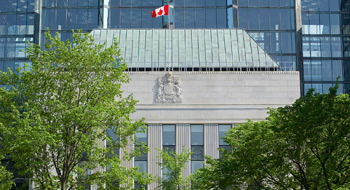
The Bank of Canada’s trend-setting interest rate shouldn’t be responsible for shoring up the country’s financial system, said Deputy Bank Governor Timothy Lane in a speech delivered today.
In that speech, he asks: “Should a central bank’s decisions on monetary policy account for the stability of the financial system? If so, how? We at the Bank of Canada are grappling with this question, and it’s being debated by economists and policymakers around the world.”
Read: Low equity market returns expected in medium term: survey
Lane adds: “Finding the right answer now seems more urgent than ever. The global financial crisis that began eight years ago has taken an enormous toll, both economic and, more important, human. Around the world, including in Canada, the crisis ushered in a period of subpar economic growth and inflation, which continues to the present day.”
Avery Shenfeld, chief economist of CIBC World Markets, says in a research note that Lane doesn’t hint at future policy moves. Lane primarily addresses the conflict between the BoC “trying to keep the economy moving back to its inflation target (and implicitly, a zero output gap) and financial stability when, as is now the case, there are concerns about household indebtedness and the role that low rates play […] BoC research [finds] the rate move needed to make a difference in the latter would entail too high a cost in terms of getting back to the inflation (and output gap) targets.”
Rather than depend solely on interest rates, Lane suggests other regulatory measures are needed to help maintain financial stability and the economy, and the Bank is trying to figure out which combination will be most effective. He says some of the regulatory measures that can be used, outside of interest rate adjustments, include tightened mortgage-financing regulations that have been introduced in recent years.
Read: Dismal start to 2016 signals more challenges ahead
He explains, “The changes in mortgage finance regulations that we have seen in the last eight years in Canada include […] the government successively increase[ing] required down payments. [This] was partly to reduce the taxpayer’s longer-term exposure to the housing market, and partly to restrain the ongoing buildup of financial system vulnerabilities associated with rising household indebtedness and housing prices.”
Lane notes measures such as government spending or fiscal stimulus may be necessary in some cases, though he warns that excessively expanding public debt can have its own negative effects. The Bank says the most concerning vulnerability is the combination of climbing household debt and elevated house prices–this a situation the Bank predicts will continue to edge higher due to the prolonged period of low interest rates.
Read: Bank of Canada holds key rate at 0.5%
Overall, his speech offers little insight into the Bank’s current strategy. But it does examine the role of monetary policy and its potential effects on the economy. As Lane says, “Looking at the historical evidence, it would be fair to conclude that few, if any, crises have been caused by monetary policy alone […] But it is likely that monetary policy played at least a contributing role in encouraging the buildup of leverage and asset prices in fragile financial system[s]. The nature and importance of that role in the run-up to these and other crises is the subject of ongoing research and debate.”
This article was originally published by Benefits Canada‘s companion site, Advisor.ca
